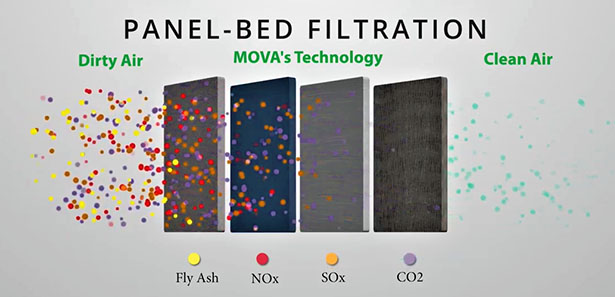Graphic: The MOVA Technologies process allows individual pollutants to be isolated separately so they can be resold to other companies.
Region looks to pivot from “coal country” to “energy innovation capitol of the east coast”
by Scott Robertson
The image of Southwest Virginia as a region reeling from the decline of the coal industry was earned fairly. But a newly formed organization, the Southwest Virginia Energy Research and Development Authority, is aiming to reshape the region’s energy economy using entrepreneurship and innovation. Formed by action of the Virginia General Assembly in 2019, the authority named Mike Quillen, former CEO of Alpha Natural Resources as its first chairman. “This authority is going to think outside the box on energy projects that bring together innovative research, workforce development, and economic development under one umbrella,” Quillen said. “Our team is going to think creatively and strategically on how to to pair renewable energy with job-creating projects.”
To that end, the authority is already working on four projects, any one of which could potentially create jobs and investment.
Project Revolution

The project that’s furthest along is the work being done by MOVA Technologies. MOVA announced June 29 it had successfully completed proof-of-concept testing at Virginia Tech and is moving on to seek partners for real-world pilot projects in commercial settings.
Naming MOVA’s work on filtration of airborne pollutants “Project Revolution” may sound like hyperbole, but if the technology can be brought to scale for commercialization, revolutionary might just be an accurate description.
“Existing technologies that remove particulate matter and scrubbers that remove gaseous pollutants fail to meet the complex needs of today’s industries,” said Luke Allison, MOVA spokesman. “When pollutants enter current filtration devices, the filters simply trap all pollutants in a single storage area, creating a toxic mixture. Once this toxic mixture is created, the captured pollutants cannot be recovered for any further use.
“MOVA’s panel-bed filter is designed to use solid sorbents to simultaneously filter both particulate matter and gaseous pollutants while segmenting those pollutants upon filtration. Each panel bed is equipped with a solid sorbent designed to remove one specific pollutant.”
The key is that the extracted pollutants can be extracted and recycled, taking what had once been only a toxic by-product and turning it into a secondary product capable of producing a new revenue stream.
For instance, fly ash can be sold to companies that make cement. Nitrogen oxide can be used in the production of pharmaceutical anesthetics, fertilizers and food preservatives. Sulfur dioxide can be sold to paper companies, and so on.

While the first thoughts for such a technology likely turn to the energy marketplace, especially in the far east where coal-fired plants still generate a majority of electrical power, there are much broader uses for the technology, said MOVA Technologies CEO Steve Critchfield. “Imagine a device placed in a poultry or swine facility that eliminates any odors caused by methane and hydrogen sulfide, or imagine a device placed on an energy production facility that eliminates the need to capture pollutants and store them in bags. That is our technology. We believe there are multiple opportunities for strategic partnerships to both deploy our technology and to further customize our chemical sorbent compounds.”
InvestSWVA is partnering with MOVA Technologies to site a pilot scale test in Southwest Virginia. “This project will sustain jobs and tax revenues on the legacy side,” said Will Payne, director of both InvestSWVA and the authority. “And on the technology side, it will create new job and investment opportunities that are not being utilized in Appalachia today. In addition, MOVA’s technology will help companies achieve their sustainability goals. And, we can clean up the environment too.”
Critchfield told a virtual news conference that he was committed to launch the pilot project somewhere in GOVa’s Region One, which is comprised entirely of Southwest Virginia counties.
Project Energizer
Two scientists from Liberty University, Dr. Thomas Eldredge and Dr. Hector Medina, are working on a plan by which power will be generated using the topography and natural resources of southwest Virginia. The pump-storage hydro (PSH) system. Water is stored in reservoirs at the tops of hills, allowed to flow downhill through a powerhouse into reservoirs further downhill, then pumped back to the upper reservoirs. The energy generated at the powerhouse is greater than that used to pump the water, creating a net gain.
Worldwide, PSH systems are costly and slow to build, but most are large operations in the 200-megawatt range. Project Energizer seeks to create smaller, modular closed-loop systems with an approximate power capacity range of 1 to 10 megawatts.
The problems being addressed are reducing the costs for materials and construction, improving the ease of installation, and expediting the project development timeline. A secondary objective of this work is to facilitate standardization of components, to the extent possible, so that replication of similar PSH systems does not require a complete redesign, according to a project summary.
GO Virginia funds will be used to procure contract services for location vetting. Those funds will also support Virginia Department of Mines, Minerals and Energy (DMME) hourly work to support location vetting and materials testing and analysis to be completed by Liberty University.
The project has a current budget of $197,000, with GO Virginia funds covering $50,000 of that. The Lenowisco Planning District is also supporting Project Energizer.
Project Oasis
First introduced at an August 2019 press conference in Wise, Project Oasis seeks to use water currently in abandoned coal mines as a coolant which could be used to make it more cost-efficient for technology companies to locate data centers in southwest Virginia. Invest SWVA and the DMME are partnering to study the development of tools that prioritize power and fiber network availability and the potential of mine pool water reclamation.
Project Innovation

Project Innovation is the hub that will bring it all together, Payne said. “Just like Project Oasis, I think we’re going to have a dream team of folks here to develop this the right way.” The basic structure is that of a business park model, but with a significant difference.
“The park will be operated by a private entity that will secure private dollars and grant funds and will manage the site or sites, including the public and education components,” Payne said. “That entity will market the opportunity to energy companies and entrepreneurs and ultimately develop projects like Energizer, Revolution and Oasis.
“Project Innovation presents the single greatest opportunity for Southwest Virginia to redefine itself,” Payne added. “This will be a first-of-its-kind operation in the United States hosting companies and entrepreneurs interested in studying, perfecting and eventually commercializing their ideas. Simply put, the energy park will provide land, labs and scientific assistance to innovators in the energy industry. It will also be a facility that allows middle and high school students in southwest Virginia to see STEM-related energy projects in action.
“Though the authority was created by the Virginia General Assembly and will play a role in Project Innovation, Payne said, “This will not be a government-run entity. It will be focused on bringing in prospects and researchers to hopefully commercialize their technology.”
Right now, the main funding question for the project isn’t about getting it built, said Will Clear, DMME director of Finance and Procurement. It’s sustainability. “It’s a lot easier to obtain grant dollars to buy land, and there’s been a whole lot of work done on the land and the water assets in southwest Virginia. But it’s not that easy to create dollars to manage this. I think that’s where the real work is going to be done. It’ll require some flexibility and creativity. To me, there’s almost got to be a tie-in with some venture capital money.”
The mere fact that southwest Virginia is being mentioned as a destination for venture capital funds in renewable energy projects represents a significant departure from the region’s nationwide perception. Payne, Clear, Critchfield, Quillen and a host of other players are determined that both the projects and the departure from old perceptions are sustainable.




